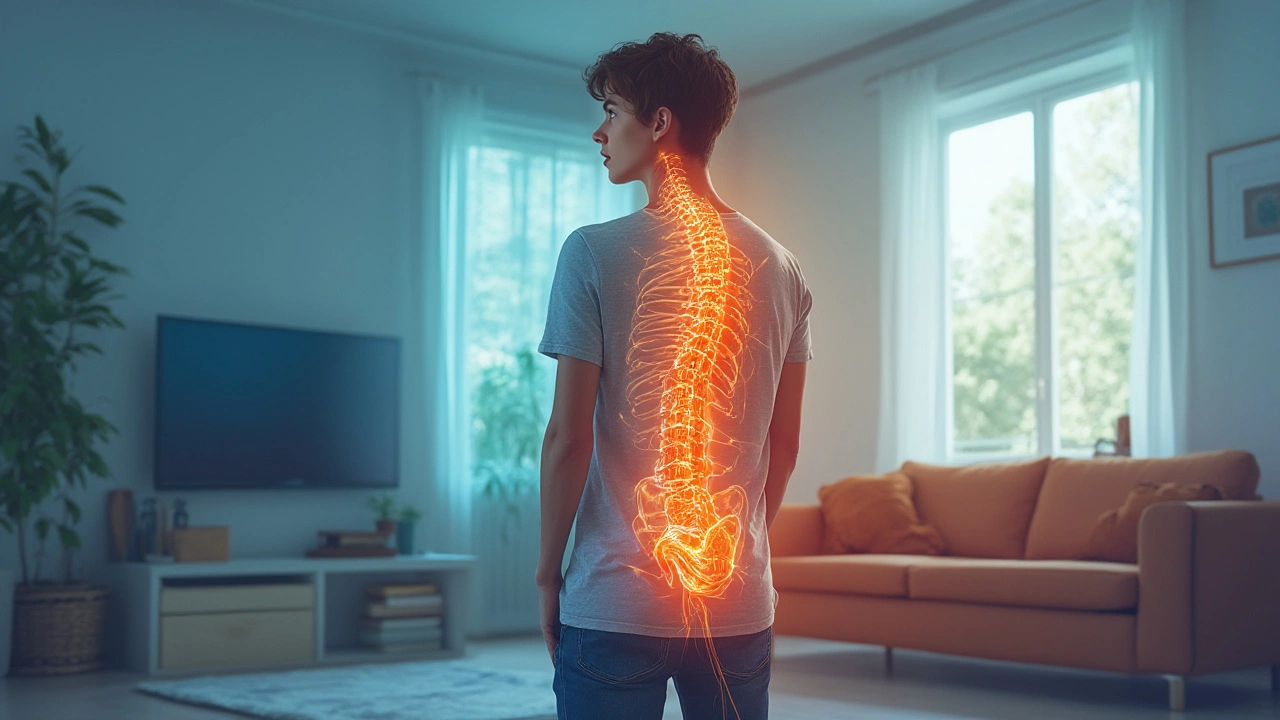Picture this: you’re not just hunched over from back pain, but now your gut is acting up, too. For some, ankylosing spondylitis and inflammatory bowel disease aren’t two different strangers—they’re part of the same frustrating story. About 6–14% of people with ankylosing spondylitis (AS) also get inflammatory bowel disease (IBD). That’s not just a wild coincidence. Symptoms can tag-team you, flare up together, and even confuse your doctors. There’s science behind why your spine and your intestines can both become battle zones.
How Ankylosing Spondylitis and IBD Interact
Ankylosing spondylitis is a type of arthritis that mainly targets your spine and sacroiliac joints—those little connectors in your pelvis. Over time, chronic inflammation can cause these bones to fuse. But this disease doesn’t always stick to your spine. It can get a little adventurous. If your immune system is the overzealous guard dog of your body, AS is what happens when it gets a little too bitey. The kicker? Ankylosing spondylitis tends to show up in your teens or twenties. IBD—which mostly means Crohn’s disease or ulcerative colitis—shows up around the same ages.
So what’s really going on? About 10% of people with AS also have IBD. Dig deeper, and studies show that up to 60% of AS patients have subtle gut inflammation even if they don’t complain about stomach symptoms. The reverse is true, too. People with IBD are more likely than average to develop joint pain or arthritis. They might never become fused at the spine, but their joints can swell and ache.
Let’s talk genetics. A gene called HLA-B27 is a major suspect in AS. If you have this gene, you’re a lot more likely to have ankylosing spondylitis. Oddly enough, this gene can also pop up in people with IBD who have joint involvement. The immune system in both conditions is a little too easily triggered, confusing friendly tissue in your gut or spine with genuine threats.
Notice a pattern with your symptoms? A bad day with your bowels sometimes matches up with extra stiffness? Yep, the two can flare together. If you’re unlucky, treating one doesn’t always keep the other under control. Some meds work for both, others only for one. Navigating life with both means tuning in to what sets you off. For some, a high-fat burger is an instant regret in the gut… for others, it’s a missed dose of medication or stress at work.
For anyone wrestling with AS and IBD, regular communication with a rheumatologist AND a gastroenterologist is essential. Sometimes one doctor’s great idea is another doctor’s red flag. Let them compare notes. This isn’t the time for either/or care—it’s both/and.
Let’s put some quick numbers in a table for fun (and clarity):
| Condition | % of AS patients affected | Common symptoms |
|---|---|---|
| Inflammatory Bowel Disease | 6–14% | Abdominal pain, diarrhea, bloody stool |
| Silent Gut Inflammation | Up to 60% | No obvious GI symptoms |
| Joint Issues in IBD patients | About 13% | Joint pain, swelling |
Bottom line: the connection is real, and it can shape your whole life—from the foods you order, to the shoes you pick, to the doctors you keep on speed dial.

Recognizing Symptoms and Triggers
You know those people who seem to shrug off a random ache or a bathroom mishap? Living with both ankylosing spondylitis and IBD means you become an expert at noticing patterns. A stiff back in the morning? Normal. But tossing in cramping, bloating, or an urgent dash to the bathroom? That combo can point toward overlapping problems.
AS symptoms often start quietly. Maybe you feel stiff when you get out of bed, or you can’t really touch your toes anymore. Over time, that stiffness turns to pain, usually starting in the lower spine or buttocks and then creeping its way up. Some days, the pain is relentless. And it loves to test you at night. If you toss and turn or can’t find a comfy position, you’re not alone. Fatigue is another unwelcome guest. Chronic inflammation doesn’t just target joints; it drains your energy, leaving you wiped out and irritable.
Now, IBD symptoms like diarrhea, urgency, or bloody stools tend to be pretty hard to ignore. Think of them as your gut’s version of a smoke alarm. When your insides are inflamed, you feel it. Some people also lose weight without trying, get mouth ulcers, or feel like they’ve got the flu all the time. IBD can be sneaky, though. Some folks only learn they have it when a colonoscopy shows hidden inflammation—no obvious symptoms, just a silent storm brewing.
The wild thing? For a decent chunk of people, their joint pains worsen when their bowels are acting up. The opposite happens too. When gut inflammation settles down, their joints sometimes calm down as well. Others find no connection at all. No one-size-fits-all here!
Here are some tips for recognizing triggers and keeping track of what sets you off:
- Keep a symptom journal. Jot down when pain, stiffness, urgency, or stomach troubles show up. Over a few weeks, you’ll see trends.
- Note what you eat, how you sleep, and your stress levels. Sometimes spicy food, no sleep, or an argument with your boss is all it takes.
- If you’re on medication, track any missed doses and what happens after. Some people notice a flare within a day or two.
- Don’t forget about infections. A simple cold or stomach bug can make symptoms worse in both conditions.
- If you have a new pain, swelling in a joint, or sudden GI changes, contact your doctor. Don’t wait, especially if you have a fever or bloody stool.
- Ask your doc about vitamin D and bone health. Both diseases can weaken bones. A simple blood test can show if you’re low.
- Exercise may help. Swimming, walking, and yoga can keep your spine flexible and your stress levels down.
It’s almost like you’re a detective, piecing together clues to figure out how your body ticks. The key is to stay curious, not get discouraged by setbacks, and involve your care team every step of the way.

Treatment, Lifestyle and Living Well With Both Conditions
Treating two chronic, immune-driven conditions at the same time isn’t for the faint of heart, but there’s good news: plenty of strategies are out there, and more people than ever are living full, active lives with AS and IBD.
Medications often overlap. Anti-inflammatory drugs like NSAIDs (think ibuprofen) help fight joint pain from AS, but can worsen symptoms in people with IBD. For those unlucky enough to need both, the real superstars are biologic medications. These are drugs that target specific troublemakers in your immune system. The most famous: TNF inhibitors like infliximab and adalimumab. They dampen inflammation in your gut and your joints. About 40% of people with AS improve with TNF blockers, and a similar number see their IBD symptoms dialed down.
Some people need different meds for each condition, so coordination is key. Methotrexate, sulfasalazine, and corticosteroids have their place. The main trick is avoiding drugs that help one condition but make the other worse. That’s why you need both a rheumatologist and a GI specialist, not just one or the other.
Beyond the pharmacy, lifestyle tweaks matter a ton. Here’s how to stack the odds in your favor:
- Ankylosing spondylitis: Regular movement is crucial. Stretch those joints every day. Swimming is magic because it works your whole body without stressing angry joints.
- IBD: Trigger foods are different for everyone, but common culprits include greasy snacks, too much fiber, dairy, and artificial sweeteners. Tracking what makes you flare up is worth the time.
- Stress management: Stress isn’t just a mental thing. It can literally trigger flares in both conditions. Mindfulness, therapy, and even just calling a friend can make a difference.
- Sleep: Bad sleep makes inflammation worse. Try a simple routine. No screens an hour before bed, and keep your bedroom as cave-like as possible—cool, quiet, and dark.
- Bone health: Long-term inflammation steals calcium from bones. Weight-bearing exercise (think walking or gentle strength work) and getting enough vitamin D help.
- Quit smoking: Smoking doubles your IBD risk and makes AS worse. Even secondhand smoke can ramp up symptoms.
- Vaccines: Chronic inflammation and immune-suppressing drugs mean you’re at higher risk for infections. Stay up to date on all vaccines, especially flu, pneumonia, and shingles.
Living with both AS and IBD isn’t a sentence to a restricted life. Plenty of people work full-time, travel, and even run half-marathons. You might need to scout out bathroom locations or take time to stretch on long car rides, but you’re not stuck on the sidelines. Facebook and Reddit have active support groups for people juggling both. It’s weirdly comforting to share tips and war stories with someone who gets it.
One thing that helps? Keeping all your medical info organized. If you see two or more specialists, bring a list of your medications to every appointment. Take pictures of your x-rays, lab results, or colonoscopy reports—just in case. If you end up in the ER, you’ll have quick proof of what’s normal for you and what’s not.
Don’t ignore the mental stuff. Depression and anxiety are more common in people with chronic inflammation. Notice changes in your mood, energy, or interest in favorite activities—it’s okay to ask for help, from your doctor, a therapist, or a trusted friend.
New research is happening now. Drugs like IL-17 inhibitors and JAK inhibitors are giving hope where old treatments didn’t work. Some centers are studying gut bacteria (the microbiome) to figure out if targeted diets or probiotic treatments could help in the future. If you have a chance to join a clinical trial, ask your care team about the risks and benefits.
The science isn’t all figured out, but the connection between your spine and your gut is real, and it matters. Keep learning, keep advocating for yourself, and don’t let two diagnoses decide how you live.

Just went through my first flare-up with both AS and Crohn’s and honestly? This post nailed it. 🙌 I didn’t even realize my back pain was tied to my gut until my rheum doc asked if I’d been having diarrhea. Turns out, yes. Every. Single. Time. Now I track my meals like a food detective. Also, swimming saved my life. No cap.
Okay but let’s be real-this whole ‘spine and gut are besties’ thing is just Big Pharma’s way of selling you $10,000 biologics. I’ve had AS for 12 years and my gut’s never acted up. Meanwhile, my cousin eats nothing but kale and tacos and still gets ‘silent inflammation.’ Sounds like a made-up diagnosis to me. Also, why is everyone suddenly into ‘microbiomes’? Did we just forget about good ol’ ibuprofen?
Oh wow, another ‘you’re not alone’ post. How original. Let me guess-you also meditate, drink bone broth, and think your ‘immune system’ is a sentient being that needs ‘rebalancing.’ I’ve got AS and ulcerative colitis, and the only thing that ‘flares’ is my patience with people who treat chronic illness like a Pinterest board. You don’t ‘overcome’ this. You learn to live with it while your insurance denies your meds. And yes, I know about TNF inhibitors. I’ve been on three. None of them fixed my soul. 😌
This is the most dangerous kind of content. It gives false hope. Biologics don’t cure anything. They just delay the inevitable. And the ‘exercise helps’ advice? That’s what you say when you’ve never had a spinal fusion. I’ve done yoga, swimming, Pilates, and now I’m on disability. The only thing that ‘works’ is not getting sick in the first place. Which, spoiler: you can’t control.
While the article presents a comprehensive overview of the clinical correlation between ankylosing spondylitis and inflammatory bowel disease, the informal tone and reliance on anecdotal evidence undermines its scientific credibility. Furthermore, the inclusion of unverified lifestyle recommendations, such as ‘cave-like bedrooms,’ lacks empirical support and may mislead patients seeking evidence-based guidance.
My gut and my spine have been having a quiet war since I was 19. I don’t need a table to tell me they’re connected. I just need to skip the nachos and not sleep on my stomach. The real villain? Stress. And doctors who don’t talk to each other. I’ve had three gastro docs and two rheum docs. None of them ever emailed each other. So I became the middleman. And yes, I still have to explain what HLA-B27 means every time. 🤷♂️
You’re not broken. You’re not failing. You’re just navigating a system that wasn’t built for people like you. That’s not your fault. Keep tracking your symptoms. Keep asking for help. Keep swimming. Keep laughing even when your body feels like a betrayal. You’re not alone in this. I’ve been where you are. And I’m still here. You’ve got this. One day at a time. 💪
ok so i had a flare last week and i think it was the dairy + my cat jumping on my back at 3am?? i swear my spine screamed. and then my gut went full riot. i forgot to take my meds one night and boom. both sides of me were like ‘we’re done.’ also typoed ‘inflammation’ as ‘inflamation’ like 5 times. sorry. brain is mush.
biologics are scams. my cousin took them and got cancer. now he’s dead. so dont listen to this. just eat less sugar and pray. also dont let the doctors scare you. they just wanna make money. i fixed my AS with a lemon and a prayer. you can too. just believe.
THIS. I’m 28 and I’ve been living with both for 7 years. I used to think I was broken. Then I found a support group on Instagram and realized I wasn’t alone. I started journaling. I found a rheum doc who actually listens. I still have bad days. But now I celebrate the good ones. I just took my first solo trip in two years. I went to the beach. I swam. I didn’t care if I had to find a bathroom every 20 minutes. I was free. You can do hard things. Even when your body says no.
Oh my goodness, thank you for writing this!! I’ve been trying to explain to my mom that my back pain and my diarrhea are connected, and she just thinks I’m being dramatic. Now I can just send her this! Also, I started taking vitamin D last month and my morning stiffness has decreased by like 50%! I didn’t even realize I was deficient. And yoga-oh my gosh, yoga changed my life. I do 10 minutes every morning before I even get out of bed. It’s not perfect, but it’s mine. You’re doing better than you think. Seriously. 💖
Of course the article tells you to ‘track your food’-as if the solution to autoimmune disease is just… eating better. Like the problem is that you didn’t eat enough quinoa. Meanwhile, the real issue is that your immune system is genetically programmed to self-destruct. And no, ‘mindfulness’ won’t fix your fused vertebrae. This is just wellness culture pretending to be medicine. How quaint.
The article references HLA-B27 as a primary genetic marker, yet fails to address the fact that 80% of HLA-B27-positive individuals never develop AS. This is a classic case of correlation misinterpreted as causation. Furthermore, the suggestion that microbiome modulation may play a therapeutic role lacks robust clinical validation. One must question the editorial standards of this piece. It reads like a blog post masquerading as medical advice.
Wow, someone actually said ‘swimming saved my life.’ That’s cute. I’m sure your yoga mat is also your therapist. Meanwhile, I’m the guy who got kicked out of a physical therapy class because I couldn’t bend over without screaming. So yeah, I’ll take my NSAIDs and my sarcasm. Thanks for the ‘hope’ though. 😒